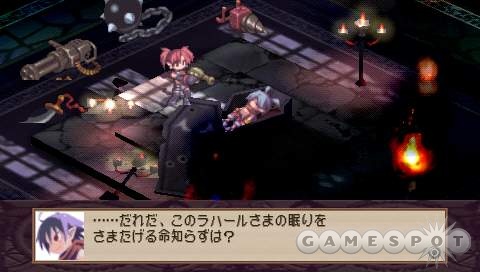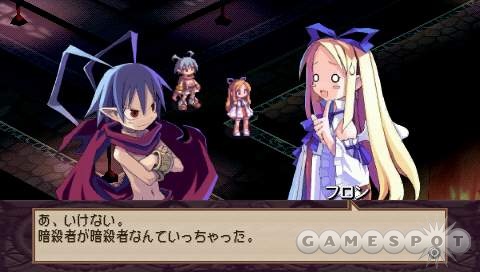When Disgaea originally came out for the PlayStation 2 in 2003, its cutesy graphics, intensely humorous story, and powerful gameplay systems quickly made it a favorite of the fans of the strategy role-playing game genre. Now a sequel and four years later, the original has been faithfully ported to the PSP system with an extra story mode, a slick widescreen presentation, and ad-hoc multiplayer, all of which stacks new layers of replayability on an already highly replayable game. For anyone with a PSP and an interest in strategy RPGs, Disgaea: Afternoon of Darkness belongs in your collection.
For those who haven't had the chance to experience it already, Disgaea: Afternoon of Darkness tells the heartwarming tale of the spoiled brat Laharl, prince of the netherworld, who wakes up from a nap two years too late to inherit the title of overlord from his deceased dad. As a result, he decides to take his birthright by force. Wait, that doesn't sound very heartwarming, does it? You'd be surprised. Joining him for the ride are his untrustworthy vassal Etna; an angel trainee-turned-unlikely assassin that's obsessed with the power of love; a defender of justice from outer space and his multipurpose superrobot; and a gaggle of exploding penguins called prinnies. As you can probably tell, Disgaea doesn't make much of an effort to take itself seriously, but its incredibly absurd humor is precisely what makes it so endearing.

The game's ridiculous and genuinely funny story is divided up into a series of chapters, each of which has a particular goal--such as "raid and loot the rich demon's palace"--that is achieved through a number of battles. Between each of these fights, you'll return to your own citadel to heal, restock on items, and purchase new gear. You can also return to any of your previous battlefields as many times as you like to work on raising your levels and earning new equipment. It's a welcome feature for those who want to experiment with a variety of party configurations or who love to obsess over creating the most powerful team they can imagine--whereas most RPGs cut you off at 100 levels, Disgaea won't stop you from reaching thousands of them.
Combat itself is where the vast majority of your time will be spent, and much like the rest of the game, its eccentricities run high. The action unfolds in an isometric view, and you can deploy up to 10 of your characters into combat per battle from your "base panel." Battles are entirely turn-based, and your characters can perform standard actions such as cast spells or attack, and even some stranger ones such as picking up and throwing other characters or enemies. You always get to move first, and once you've finished deploying your units, positioning them, and performing their actions, it's the enemy's turn. After that, it's back to you, and so forth. If you have allies adjacent to one another when they execute attacks, there's a chance they'll perform combo attacks, and some of the battlefields even have colored panels that can provide bonuses or penalties to any unit standing on them if an object called a geo symbol is affecting the panel. These symbols can do anything from increase the number of consecutive attacks performed, to the ability to deal damage every turn, and destroying them can cause spectacular effects that dish out huge damage to enemies.
Character creation and training is another aspect of the game that you will spend a great deal of time on. Besides the story-related characters that join your party, you can create new ones by spending the mana that you earn by slaying enemies. There is a huge variety of classes available to choose from, and even more open up to you as you progress through the game. Once you've gone as far as you want with a specific class, you can transmigrate to a new one by resetting to level one and transferring over some of your stats and skills, and then continue this process as much as you like to create the ultimate warrior. This is all done by petitioning the netherworld's dark assembly, a group of demonic senators who can also be summoned to request things such as a larger selection of items at the stores or an increased counterattack rate. Though they may not always agree with you, other options such as bribing them with items to garner votes or simply beating them into submission are certainly possible, and often expected, in the netherworld.
Once you've finished up with the main story campaign, which should take you roughly 30 to 40 hours, there's certainly no shortage of things to do. You'll be able to restart the story from the beginning and carry over your levels, troops, and equipment to try to get a different ending, and there are a ton of powerful optional bosses to fight and extra areas to explore. There's also the item world--literally the world inside each of your items--where you battle through progressively difficult, randomly generated floors to make your gear more powerful. An entirely new feature is Etna Mode, a separate campaign with its own hilarious story and dialogue told entirely from Etna's point of view that shows what might have happened if she had actually managed to kill Laharl in the opening scene instead of wake him up.
Another new feature is an ad-hoc multiplayer mode that lets you trade items with friends and pit your armies against theirs. These battles are highly customizable, and you'll be able to change everything from victory conditions to which items will appear on the battlefield, and whether or not there's a fog of war obscuring the map. To help balance out even the most woefully lopsided matches, each player will also get geo cubes, which are new items that let them completely change a battle by implementing game-altering effects.

In terms of presentation, Disgaea has never looked better. The supercutesy anime-inspired graphics make a seamless transition to full widescreen, and there is not an ounce of graphical slowdown to be found. In fact, this port even manages to fix frame-rate inconsistencies and lower some of the load times found in the original version. Unfortunately, one area that hasn't been improved is the lackluster camera, which can be rotated only in 90-degree chunks. Consequently, some monsters can be difficult to see thanks to map terrain. As far as the audio is concerned, the fantastic voice acting remains for the most part fully intact, as does the option to listen to the original Japanese track. Some fans will undoubtedly recognize that Etna has been redubbed with her Disgaea 2 actress, but that is an exceedingly minor quibble.
The bottom line is that Disgaea: Afternoon of Darkness is a great game for any fan of the strategy RPG genre. Though it's still relatively inaccessible to those who haven't played a strategy RPG in their life, anyone willing to invest the time necessary to figure it out will soon learn to appreciate the amount of depth the game offers. Its borderline insane characters, hilarious dialogue, and powerful combat and character-creation systems are further bolstered by a fantastic transition to widescreen and the addition of lots of new content and features. Make no mistake, this is the definitive version of Disgaea--it's finally time to retire that worn PS2 copy you've still got in your system.